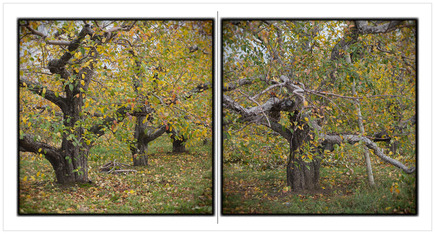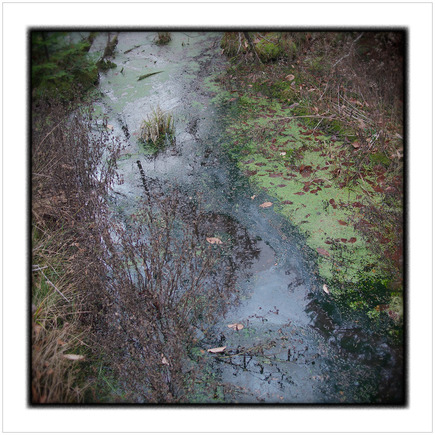 Apple orchard ~ Peru, NY - in the Adirondack Park • click to embiggenOK, apple trees are are part of the natural world but apple orchards are humankind made enterprises. So, is this diptych a ku or is it a civilized ku? Or, alternatively, is it just a couple of pictures thrown together for togetherness sake?
Apple orchard ~ Peru, NY - in the Adirondack Park • click to embiggenOK, apple trees are are part of the natural world but apple orchards are humankind made enterprises. So, is this diptych a ku or is it a civilized ku? Or, alternatively, is it just a couple of pictures thrown together for togetherness sake?
A bit of background (I'd use the word "history", but I'd never hear the end of it from the wife), re: the word "ku" - 6 years ago, I explained my use of the word in my picture naming convention here. Since that time, I have come across other notions and ideas of the use of the word, which have expanded my idea of Ku˜, such as this:
This paper presents a design project that explored the practice of “noticing”. Noticing is a way in and through which we are able to understand and create our relationship to space and place. The practice of noticing can facilitate awareness, reflection, learning and transformation. Noticing is a practice that enables us to engage with the concept of Ku˜, meaning “space”, in Japanese. In this project context, Ku˜ is interpreted as a space of potentiality rather than emptiness or nothingness. Engaging with Ku˜ through the practice of noticing can enable a transition from abstraction to meaning. Ku˜ can also be an expression of the ambiguous potential of design - ed: I will substitute "picturing making" for "design" throughout the rest of this writing - investigations: including knowing and the unknown, the limitations and the challenges. To practice picture making in this way is to step outside of the confines of certainty and embark on an exploratory path of discovery. Just as picture making is a way of engaging with space – to enunciate the unknown, to create meaning from the abstract – so too is noticing as a temporal practice of discovery and place making. Through the act of noticing the ambiguous openness of space is transformed into the connectedness of place. ~ from an academic paper, Engaging with Ku˜: from abstraction to meaning through the practice of noticing by Yoko Akama
That written, and of late, I have been thinking about my use of the word "ku" in my picture naming convention. That ruminating was instigated by several notions which have been randomly popping up in my head...
notion 1 - perhaps the word "ku" has become redundant and might better be relegated to use in an general artist statement regarding my picture making intentions.
notion 2 - at one time, I thought the distinction between my pictures of the natural world and those of the humankind made world were important enough to justify the separate nomenclatures of "ku" and "civilized ku". Whereas now, I have come to realize both picturing activities as part of the same act of "engaging with space".
notion 3 - in considering notions 1 and 2, I am leaning toward the idea of just going with simple descriptions, such as today's "Apple orchard, Peru, NY", as the only words accompanying my pictures.
notion 4 - in all of my separate bodies of work, the word "ku" is no where to be seen / read. In fact, other than simple titles for each body of work, there are no other words of any kind accompanying each picture.
Relative to notion 4, I have quite a few picture books - most notably, WILLIAM EGGLESTON 2¼* (highly recommended) - in which there are precious few words of any kind. In the Eggleston book, there is only a title page and a publisher's page (the last page in the book).
There are no intro, artist statement, or art-speak essays. The pictures have no titles or information of any kind. It is one of purest examples of let-the-pictures-speak-for-themselves I have ever viewed.
All of that written, I guess all I am saying is, don't be surprised if picture titles/names on this blog go the way of the Dodo bird - although, I will keep using journal category tags in order to facilitate the viewing of related pictures.
*Yes Virginia, there is a book of Eggleston pictures comprised of just some of his square pictures
 Tuesday, January 22, 2013 at 03:29PM
Tuesday, January 22, 2013 at 03:29PM  Fog bank and low-lying mist on Lake Champlain ~ Plattsburgh, NY • click to embiggenYet again, I have been ripped from my computer by real-world activities.
Fog bank and low-lying mist on Lake Champlain ~ Plattsburgh, NY • click to embiggenYet again, I have been ripped from my computer by real-world activities.







